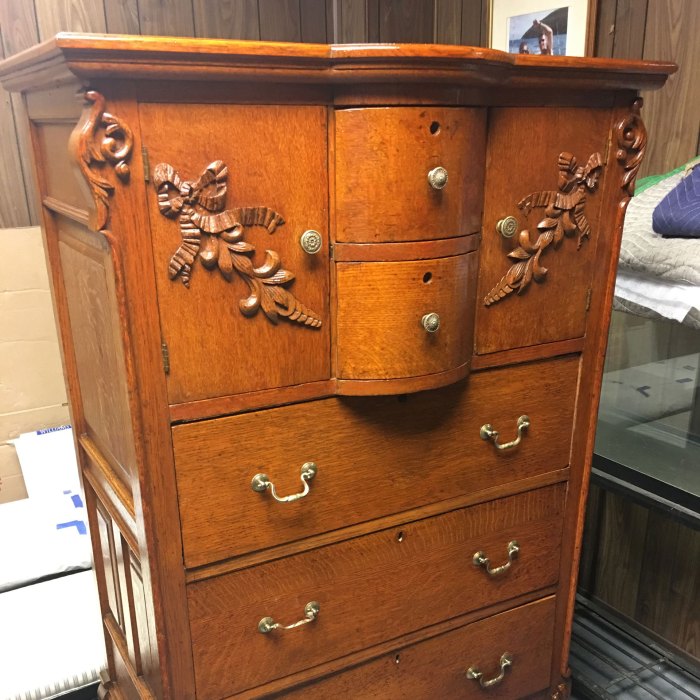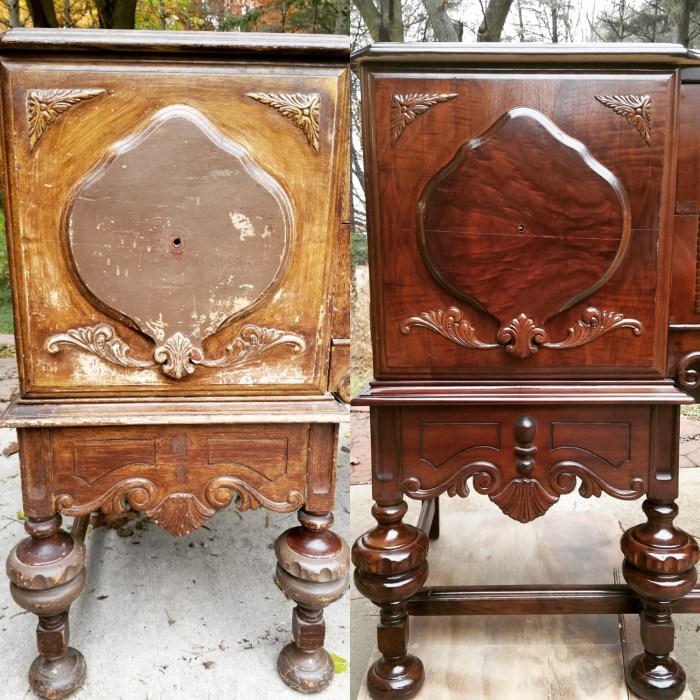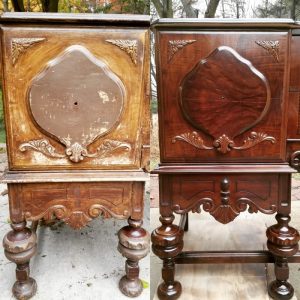
Vintage furniture restoration is more than just repair; it’s a meticulous process of reviving cherished pieces, breathing new life into heirlooms and iconic designs. This involves a deep understanding of various wood types, finishes, and upholstery techniques, demanding both skill and patience. From identifying the age and style of a piece to selecting the appropriate tools and materials, the journey of restoration is a blend of art and science, preserving history while enhancing beauty.
This guide delves into the intricacies of restoring vintage furniture, covering everything from identifying common materials and employing appropriate repair techniques to understanding the value and appreciation of these unique pieces. We will explore the distinctions between repair, restoration, and refinishing, providing practical advice and step-by-step guidance to help you successfully undertake your own restoration projects.
Vintage Furniture

The allure of vintage furniture lies in its unique blend of history, craftsmanship, and enduring style. These pieces offer a tangible connection to the past, reflecting the design aesthetics and social trends of their respective eras. Understanding the different styles and periods allows for a deeper appreciation of their artistry and value, informing both restoration efforts and informed collecting.
Vintage Furniture Styles and Periods
A wide array of styles characterized vintage furniture production. Each period reflects the prevailing artistic movements, technological advancements, and societal influences of its time. Identifying these stylistic elements is crucial for accurate restoration and informed appreciation.
Art Deco (1920s-1930s)
Art Deco furniture is characterized by its geometric shapes, streamlined forms, and luxurious materials. Think bold zigzags, stepped profiles, and the incorporation of exotic woods like ebony and macassar. Chroming and lacquer finishes were frequently employed to create a sleek, modern aesthetic. Iconic pieces include the chaise longues designed by Eileen Gray, known for their elegant curves and luxurious upholstery, and the distinctive geometric shelving units that defined the style’s emphasis on clean lines and functionality.
A visual representation might show a low, sleek chest of drawers with inlaid geometric patterns in contrasting woods, polished to a high shine, sitting on tapered legs with a subtle chrome accent.
Mid-Century Modern (1930s-1960s)
Mid-Century Modern furniture emphasizes clean lines, organic forms, and functionality. Materials like teak, rosewood, and molded plywood were favored, reflecting a post-war focus on affordability and mass production. This style often incorporates tapered legs, curved backs, and simple, uncluttered designs. Iconic examples include the Eames Lounge Chair and Ottoman, known for its comfortable molded plywood shell and elegant base, and the iconic tulip chairs by Eero Saarinen, showcasing a sculptural base and a smooth, molded seat.
Imagine a low-slung sofa with tapered legs, upholstered in a vibrant, textured fabric, featuring organic curves and a minimalist aesthetic. The wood might be a rich, dark rosewood, polished to a warm, satiny sheen.
Victorian (1837-1901)
Victorian furniture is characterized by its ornate detailing, rich materials, and opulent aesthetic. Heavily carved wood, plush upholstery, and intricate inlays were common features. Styles varied throughout the period, encompassing Gothic Revival with its pointed arches and dark woods, and the later Aesthetic Movement with its emphasis on natural forms and asymmetry. Think elaborate, high-backed chairs with intricate carvings, massive wardrobes adorned with mirrored panels and decorative hardware, and heavy, ornately carved sideboards.
Visualize a large, imposing writing desk made of dark, polished mahogany, featuring intricate carvings of floral motifs and mythical creatures, adorned with brass hardware and inlaid mother-of-pearl. The desk sits on four sturdy, turned legs, each capped with a decorative finial.
The Value and Appreciation of Vintage Furniture

Owning a piece of vintage furniture is more than just possessing a piece of the past; it’s an investment that can appreciate significantly over time. Several factors contribute to the value of these unique items, making understanding these elements crucial for both buyers and sellers. Proper restoration plays a key role in maximizing this value, ensuring the piece remains desirable and retains its historical integrity.Factors Influencing the Value of Vintage FurnitureThe value of a vintage furniture piece is a complex equation, determined by a confluence of factors.
Understanding these allows for a more informed assessment of its worth.
Rarity and Demand
Rarity significantly impacts a piece’s value. Limited production runs, unique designs, or pieces from a specific era with fewer surviving examples command higher prices. For instance, a limited-edition chair designed by a renowned mid-century modern designer will likely be more valuable than a mass-produced counterpart. Similarly, furniture associated with a particular historical event or figure can command a premium.
Demand, driven by collector interest and market trends, further influences value. Styles that are currently popular amongst collectors will naturally be more expensive.
Condition and Originality
The condition of a piece is paramount. Well-preserved furniture, with minimal wear and tear, and all original components, is highly valued. Repairs, even expertly done, can diminish value, unless clearly disclosed. Originality is equally important; authenticity, confirmed through maker’s marks, labels, or provenance, significantly increases a piece’s worth. A meticulously preserved antique writing desk with its original hardware and finish will be more valuable than a similar piece with replaced parts or a compromised finish.
Maker and Designer
The reputation and significance of the maker or designer directly impact value. Renowned designers, established furniture makers, and pieces from prestigious workshops command higher prices due to their established reputation and craftsmanship. A chair by a well-known designer like Charles and Ray Eames will fetch a considerably higher price than a similar chair from an unknown maker. The maker’s mark or label acts as a critical authentication point.
Proper Restoration and its Impact on Value
Proper restoration is not merely about repairing damage; it’s about preserving the historical and aesthetic integrity of the piece. A poorly executed restoration can severely diminish value, while a professional, historically accurate restoration can significantly enhance it. Ethical restoration practices focus on preserving original materials whenever possible, using appropriate techniques and materials that are consistent with the piece’s age and style.
A well-restored piece demonstrates a commitment to preserving a piece of history, increasing its desirability and, consequently, its value.
Resources for Determining Market Value
Several resources can assist in determining the market value of vintage furniture.
Online Marketplaces and Auction Houses
Websites specializing in vintage and antique furniture, such as LiveAuctioneers and eBay, provide insights into current market prices. Auction results from reputable houses like Christie’s and Sotheby’s offer benchmarks for high-value pieces. By researching comparable pieces, you can establish a price range for your furniture.
Antique Dealers and Appraisers
Experienced antique dealers and professional appraisers offer valuable expertise. They can assess the condition, authenticity, and market value of a piece, providing a formal appraisal report if needed. Consulting multiple experts can provide a broader perspective on value.
Books and Price Guides
Numerous books and price guides specialize in antique and vintage furniture. These resources can provide valuable information on specific makers, styles, and periods, aiding in the valuation process. However, it’s important to remember that these guides provide estimates, and the actual market value may vary depending on the condition and specific details of the piece.
Presenting and Photographing Vintage Furniture
Effective presentation is crucial for maximizing the value of vintage furniture, whether selling or seeking appraisal.
High-Quality Photography
Clear, well-lit photographs showcasing the piece’s details are essential. Multiple angles, close-ups of unique features (e.g., carvings, inlays), and shots that show the overall size and scale are necessary. The background should be neutral and uncluttered, allowing the furniture to be the focal point. Images should be high-resolution to showcase the piece’s details accurately.
Detailed Descriptions
Accurate and detailed descriptions are as important as the photographs. Include information about the maker, designer, style, age, materials, dimensions, and any unique features. Clearly describe the condition of the piece, noting any imperfections or restorations. Honesty and transparency are crucial in building trust and ensuring accurate valuation. A well-written description will attract serious buyers and appraisers.
Restoring vintage furniture is a rewarding endeavor that combines craftsmanship, historical appreciation, and a passion for preserving beauty. By understanding the techniques, materials, and the unique characteristics of different furniture styles, you can breathe new life into these timeless pieces. This guide has provided a foundation for your journey; remember that patience, attention to detail, and a respect for the history of each piece are key to successful restoration and the preservation of these valuable artifacts.
FAQ
What is the difference between repair, restoration, and refinishing?
Repair addresses specific damage, restoration aims to return the piece to its original state, and refinishing focuses on updating the surface finish.
How can I determine the value of a vintage furniture piece?
Consider factors like age, maker, rarity, condition, and current market trends. Consult antiques appraisers or online resources for guidance.
What type of wood glue is best for vintage furniture repairs?
A high-quality, hide glue or a water-based wood glue specifically designed for antique furniture are generally recommended.
Where can I find reputable suppliers for restoration materials?
Specialty woodworking stores, online retailers, and antique restoration supply companies are good places to start.







